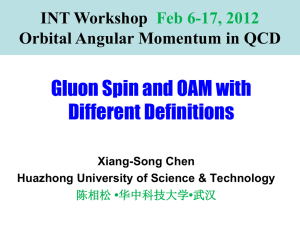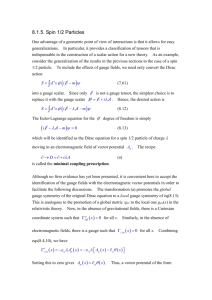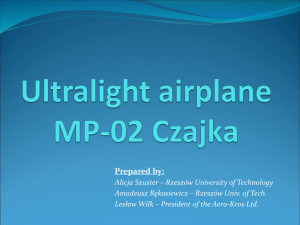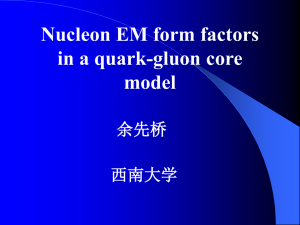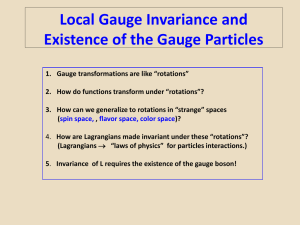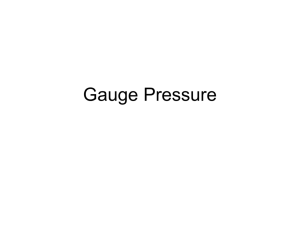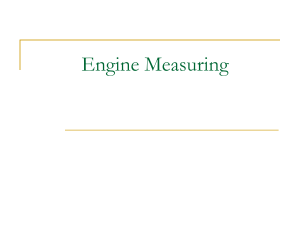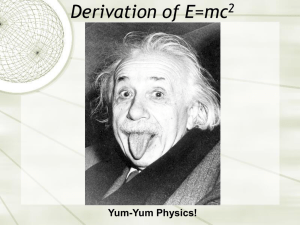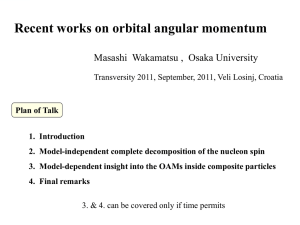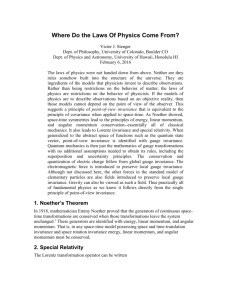Is gauge-invariance a
advertisement
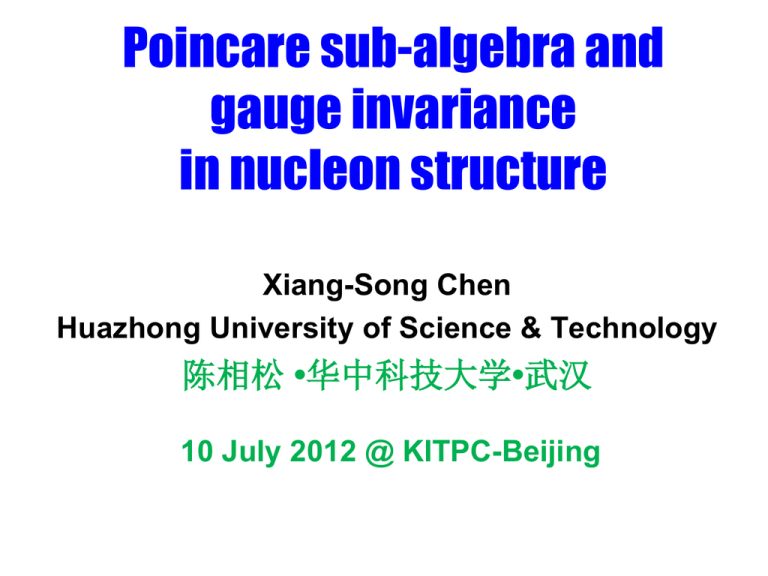
Poincare sub-algebra and gauge invariance in nucleon structure Xiang-Song Chen Huazhong University of Science & Technology 陈相松 •华中科技大学•武汉 10 July 2012 @ KITPC-Beijing Outline I. Controversy in nucleon (spin) structure II. Elliot Leader’s criteria of separating momentum and angular momentum III. Reconciling Poincare sub-algebra with gauge invariance IV. A practical thinking about nucleon structure V. A critical thinking about gauge invariance A universally correct statement for the nucleon spin Nucleon spin comes from the polarization and orbital motion of quarks and gluons --- Chairman Mao Controversy in nucleon spin structure Leader [PRD 83:096012 Jaffe-Manohar [NPB337:509 (1990)] 1 1 J total d 3 x d 3 xx d 3 xE A d 3 xx E iAi 2 i (2011)] Ji [PRL78:610 (1997)], Chen-Wang [CTP27:212 (1997)] J total d 3 x 1 1 d 3 xx D d 3 xx E B 2 i Chen-Lu-Sun-Wang-Goldman [PRL100:232002 (2008); 103:062001 (2009)] 1 1 i J total d 3 x d 3 xx Dpure d 3 xE Aphys d 3 xx E i Dpure Aphy s 2 i Wakamatsu [PRD81:114010(2010); 83:014012 (2011); 84:037501 (2011)] J total d 3 x 1 1 a d 3 xx D d 3 xE Aphys d 3 xx ( E i D pure Api hys Aphys a) 2 i Interacting theory: Structure of Poincare generators Without gauge symmetry, the issue is trivial: Lagrangian: L La Lb Lint "Good" generators "bad" generators P Pa Pb H = H a H b H int J J a J b K K a Kb Kint Spatial translation and rotation are kinematic Time translation and Lorentz boost are dynamic Interacting theory: Poincare (sub)algebra [ J i , J (ja ,b ) ] i ijk J (ka ,b ) i j k Kinematic transformation [ J , P( a ,b ) ] i ijk P( a ,b ) [ P i , P j ] 0 ( a ,b ) [ K i , J aj,b ] i ijk K ak,b Dynamic transformation i j [ K , Pa ,b ] iH a ,b ij [ K i , J j ] i ijk K k Only total J and P are covariant: i j [ K , P ] iH ij Further criteria by Elliot Leader Corollary Examination of various decompositions by Leader’s criteria Leader [PRD 83:096012 Jaffe-Manohar [NPB337:509 (1990)] 1 1 J total d 3 x d 3 xx d 3 xE A d 3 xx E iAi 2 i (2011)] Ji [PRL78:610 (1997)], Chen-Wang [CTP27:212 (1997)] J total d 3 x 1 1 d 3 xx D d 3 xx E B 2 i Chen-Lu-Sun-Wang-Goldman [PRL100:232002 (2008); 103:062001 (2009)] 1 1 i J total d 3 x d 3 xx Dpure d 3 xE Aphys d 3 xx E i Dpure Aphy s 2 i Wakamatsu [PRD81:114010(2010); 83:014012 (2011); 84:037501 (2011)] J total d 3 x 1 1 a d 3 xx D d 3 xE Aphys d 3 xx ( E i D pure Api hys Aphys a) 2 i Generators for the gauge-invariant physical fields - translation Generators for the gauge-invariant physical fields - Rotation The quark-gluon system Generator for the gaugeinvariant quark field Generator for the gaugeinvariant gluon field Some detail in the proof A practical thinking about nucleon structure Hint from a forgotten practice: Why photon is ignored for atomic spin? The fortune of choosing Coulomb gauge Quantitative differences Another example: momentum of a moving atom and nucleon Hint from a forgotten practice: Why photon is ignored for atomic spin? Do these solutions make sense?! The atom as a whole Close look at the photon contribution The static terms! Justification of neglecting photon field A critical gap to be closed The same story with Hamiltonian The fortune of using Coulomb gauge Gauge-invariant revision – Angular Momentum Gauge-invariant revision -Momentum and Hamiltonian The covariant scheme spurious photon angular momentum Gluon angular momentum in the nucleon: Tree-level 3 J ' g d x r ( E B) 0 One-gluon exchange has the same property as one-photon exchange Beyond the static approximation Momentum of a moving atom A stationary electromagnetic field carries no momentum Quark and gluon momentum in the nucleon 2ng 1 3 P d x D P s q q 9 2 d i , Q 2 dQ Pg 2 2ng Pq d 3 xE B 9 Q : 2 Pg 2ng 2ng 3n f PN 1 PN (n f 5) 2 ng 1 ˆ 3 ˆ P d x D P pure s q q 18 2 d i Q 2 Pˆ 2 ng dQ Pg d 3 xE i Dpure Ai g phys 18 Q : 2 Pˆg ng / 2 ng / 2 3n f PN nf P 3 q n f Pg 3 nf Pˆ 3 q n f Pˆg 3 1 PN (n f 5) 5 Weinberg’s approach: derivation of QED with physical photons S. Weinberg, Phys. Rev. 138 (1965) B988 S. Weinberg, Phys. Rev. 138 (1965) B988 S. Weinberg, Phys. Rev. 138 (1965) B988 The non-covariant propagator of Physical photon A delicate point: the contact term and its effect Cancelation of the contact term Is gauge-invariance a “Compromise”, or even “illusion”? Conditions Results First step in Physics:Complete Description Classic Physics: r and p(controllable) Quantum Mechanics:Wave Function (Not completely controllable) Gauge Theory:Gauge potentials (Completely uncontrollable) Need for the physical variable: Real emergence of a photon A possible real difference l=1 m=1 e B LY11 ikr i E B i A k E Flux EB J Flux E A Ei x Ai x EB dP dJ z dJ z (rad. gauge) Dipole rad. ikr d 1 cos d 1 cos d 2 2 2sin 2 If we never need physical gluons …… Then QCD is a true gauge theory, and the only try gauge theory so far known And all quark and gluon quantities are a matter of definition Do we sometimes need physical gluons? Probably, in early universe Then color gauge invariance may also be an illusion! What about SU(2)XU(1) and Higgs? Derivation of QED with physical photons by requiring Lorentz invariance Derivation of non-Abelian gauge theory with physical gluons by requiring Lorentz invariance??? Summary I. Nucleon spin and momentum can be separated gauge invariantly, with quark/gluon part acting as the rotation and translation generators for the physical quark/gluon field. II. If adopting the naive free-form expression, Coulomb gauge gives the simplest pictures for atomic and nucleon structure. III. Gauge symmetry might be an illusion. QED can be derived from physical photons by requiring Lorentz invariance of S matrix, but the situation for nonAbelian theory is more tricky and not yet proven. Thank you! 谢谢!

